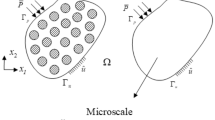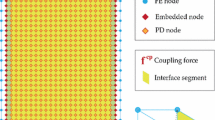Abstract
Investigation of fracture mechanics problems with computational tools has always been a great challenge due to singularities present at the crack tip. FRAC3D is an effective finite element tool that benefits from enriched element methodology. The dynamic version of this code enables the analysis of structures with stationary cracks subjected to impact loading. Response of the components in these problems are highly influenced by stress wave propagation phenomenon. In this study, bimaterial interface cracking in an electronic packaging structure is analyzed considering transient behavior. Besides the complications associated with the finite element solution of such a problem, long computational times may also be an issue considering model sizes. Multiprocessing of finite element codes could save significant times if corresponding algorithms are restructured with parallel processing tools in an efficient form. Up to 75 % reductions in time for the given example were obtained by using newly implemented multiprocessing code.
Similar content being viewed by others
References
A. O. Ayhan and H. F. Nied, Stress intensity factors for three-dimensional surface cracks using enriched finite elements, International Journal for Numerical Methods in Engineering, 54 (2002) 899–921.
M. Saribay and H. F. Nied, Dynamic stress intensity factors for suddenly loaded structures using enriched finite elements, Theoretical and Applied Fracture Mechanics, 70 (2014) 59–67.
M. Saribay, Three-dimensional elastic-plastic dynamic fracture analysis for stationary cracks using enriched elements, Ph.D. Thesis, Lehigh University, PA, US (2009).
M. Saribay, Z. Hadri, N. Rakotomala, E. Marechal and H. F. Nied, Unresolved issues associated with the simulation of 3-D fatigue crack growth in complex geometries, Special Symposium in memory of Paul Paris, Society of Engineering Science, St. Louis, MI, USA (2019).
Z. Huang, P. Kumar, I. Dutta, J. H. L. Pang and R. Sidhu, A general methodology for calculating mixed mode stress intensity factors and fracture toughness of solder joints with interfacial cracks, Engineering Fracture Mechanics, 131 (2014) 9–25.
J. Wang, Y. Niu, S. Shao, H. Wang, J. Xu, V. Pham and S. Park, A comprehensive solution for modeling moisture induced delamination in electronic packaging during solder reflow, Microelectronics Reliability, 112 (2020) 113791.
Y. Yao and L. M. Keer, Cohesive fracture mechanics based numerical analysis to BGA packaging and lead-free solders under drop impact, Microelectronics Reliability, 53 (2013) 629–637.
Y. M. Jen, Y. C. Chiu and C. H. Yu, Fracture mechanics study on the intermetallic compound cracks for the solder joints of electronic packages, Engineering Failure Analysis, 18 (2011) 797–810.
H. F. Nied, Mechanics of interface fracture with applications in electronic packaging, IEEE Transactions on Device and Materials Reliability, 3 (4) (2003) 129–143.
N. R. E. Lim, A. T. Ubando, J. A. Gonzaga and R. R. N. Dimagiba, Finite element analysis on the factors affecting die crack propagation in BGA under thermo-mechanical loading, Engineering Failure Analysis, 116 (2020) 104717.
Y. Shi, H. Chen, J. Wu, I. Shiu and F. Wong, Thermo-mechanical analysis and design for SOD package based on finite element method, IEEE Transactions on Components, Packaging and Manufacturing Technology, 2 (4) (2012) 650–659.
H. Fei, K. Yazzie, N. Chawla and H. Jiang, Modeling fracture of Sn-rich (Pb-free) solder joints under mechanical shock conditions, Journal of Electronic Materials, 41 (8) (2012) 2089–2099.
T. C. Chiu and H. C. Lin, Analysis of stress intensity factors for three-dimensional interface crack problems in electronic packages using the virtual crack closure technique, International Journal of Fracture, 156 (2009) 75–96.
S. B. Lee, I. Kim and T. S. Park, Fatigue and fracture assessment for reliability in electronics packaging, International Journal of Fracture, 150 (2008) 91–104.
K. K. Mathur, A. Needleman and V. Tvergaard, Ductile fracture analysis on massively parallel computers, Computer Methods in Applied Mechanics and Engineering, 119 (1994) 283–309.
S. Hewitt, L. Margetts, A. Shterenlikht and A. Revell, A massively parallel multiscale CAFÉ framework for the modelling of fracture in heterogenous materials under dynamic loading, Advances in Engineering Software, 139 (2020) 102737.
J. Lee, S. E. Oh and J. W. Hong, Parallel programming of a peridynamics code coupled with finite element method, International Journal of Fracture, 203 (2016) 99–104.
I. Dooley, S. Mangala, L. Kale and P. Geubelle, Parallel simulations of dynamic fracture using extrinsic cohesive elements, Journal of Scientific Computing, 39 (2009) 144–165.
Q. Liu, W. Wang and H. Ma, Parallelized combined finite-discrete element (FDEM) procedure using multi-GPU with CUDA, International Journal for Numerical and Analytical Methods in Geomechanics, 44 (2020) 208–238.
G. Yagawa, Node-by-node parallel finite elements: a virtually meshless method, International Journal for Numerical Methods in Engineering, 60 (2004) 69–102.
J. Mackerle, FEM and BEM parallel processing: theory and applications - a bibliography (1996-2002), Engineering Computations, 20 (4) (2003) 436–483.
J. R. Rice, Elastic fracture mechanics concepts for interfacial cracks, Journal of Applied Mechanics, 55 (1988) 98–103.
J. Dundurs, Edge bonded dissimilar orthogonal elastic wedges, Journal of Applied Mechanics, 36 (1969) 650–652.
Y. Saad, Iterative Methods for Sparse Linear Systems, 2nd Ed., Society for Industrial and Applied Mathematics, University of Minnesota, Minneapolis, MN, USA (2003).
Acknowledgments
Contributions from Herman F. Nied (ME&M Department, Lehigh University) are greatly acknowledged. His support was valuable for this research.
Author information
Authors and Affiliations
Corresponding author
Additional information
Murat Saribay is currently an Assistant Professor of Mechanical Engineering at Istanbul Bilgi University, Istanbul, Turkey. He received his B.S. degree in Mechanical Engineering from Bogazici University, Istanbul, Turkey in 2002. He then received his M.S. and Ph.D. degrees in 2005 and 2009, respectively, from Lehigh University, PA, US. During his career, he has been involved in multiple international projects in collaboration with industrial companies and universities. His research interests include computational mechanics, structural integrity, dynamic fracture mechanics, elastic-plastic fracture, wave propagation effects, welding, multiscale methods, and parallel processing.
Rights and permissions
About this article
Cite this article
Saribay, M. Multiprocessing implementations for time-dependent fracture analysis of an electronic packaging structure. J Mech Sci Technol 37, 2831–2841 (2023). https://doi.org/10.1007/s12206-023-0510-x
Received:
Revised:
Accepted:
Published:
Issue Date:
DOI: https://doi.org/10.1007/s12206-023-0510-x




